Marketing-Cloud-Intelligence Salesforce Marketing Cloud Intelligence Accredited Professional (AP-215) Free Practice Exam Questions (2025 Updated)
Prepare effectively for your Salesforce Marketing-Cloud-Intelligence Marketing Cloud Intelligence Accredited Professional (AP-215) certification with our extensive collection of free, high-quality practice questions. Each question is designed to mirror the actual exam format and objectives, complete with comprehensive answers and detailed explanations. Our materials are regularly updated for 2025, ensuring you have the most current resources to build confidence and succeed on your first attempt.
A client's data consists of three data streams as follows:
Data Stream A:
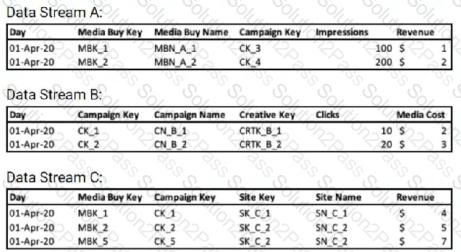
* The data streams should be linked together through a parent-child relationship.
* Out of the three data streams, Data Stream C is considered the source of truth for both the dimensions and measurements.
* Data Stream C was set as a ‘Parent’, and the ‘Override Media Buy Hierarchy’ checkbox is checked
What should the Data Updates Permissions be set to for Data Stream B?
A technical architect is provided with the logic and Opportunity file shown below:
The opportunity status logic is as follows:
For the opportunity stages “Interest”, “Confirmed Interest” and “Registered”, the status should be “Open”.
For the opportunity stage “Closed”, the opportunity status should be closed.
Otherwise, return null for the opportunity status.
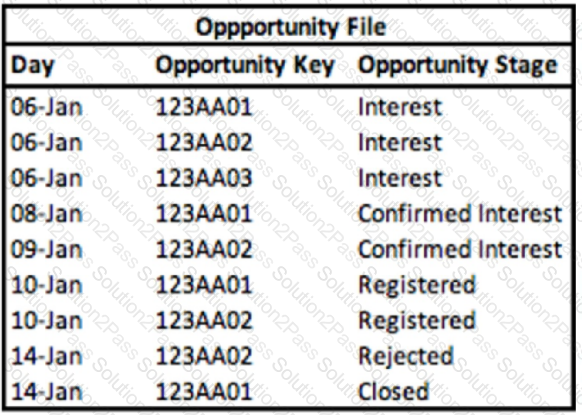
Given the above file and logic and assuming that the file is mapped in a GENERIC data stream type with the following mapping:
“Day” — Standard “Day” field
“Opportunity Key” > Main Generic Entity Key
“Opportunity Stage” — Generic Entity Key 2
“Opportunity Count” — Generic Custom Metric
A pivot table was created to present the count of opportunities in each stage. The pivot table is filtered on Jan 7th - 10th. How many different stages are presented in the table?
An implementation engineer is requested to integrate the following files:
File A:

File B:

The client would like to link the two files in order to view the two KPIS (Tasks Completed’ and ‘tasks Assignmed’) alongside’Employee Name’ and/or ‘Squard’.
A Parent-Child configuration was set between the two.
Which two statements are correct?
What are two potential reasons for performance issues (when loading a dashboard) when using the CRM data stream type?
Which three statements describe Overarching Entities? 03m 23s
A client has integrated data from Facebook Ads. Twitter ads, and Google ads in marketing Cloud intelligence. For each data source, the source, the data follows a naming convensions as …
Facebook Ads Naming Convention - Campaign Name:
CampID_CampName#Market_Object#object#targetAge_TargetGender
Twitter Ads Naming Convention- Media Buy Name
MarketTargeAgeObjectiveOrderID
Google ads Naming Convention-Media Buy Name:
Buying_type_Market_Objective
The client wants to harmonize their data on the common fields between these two platforms (i.e. Market and Objective) using the Harmonization Center. Given the above information, which statement is correct regarding the ability to implement this request?
wet Me - Given the above information, which statement i 's Correct regarding the ability to implement this request?
An Implementation engineer is requested to create a new harmonization field 'Offer’ and apply the following logic:
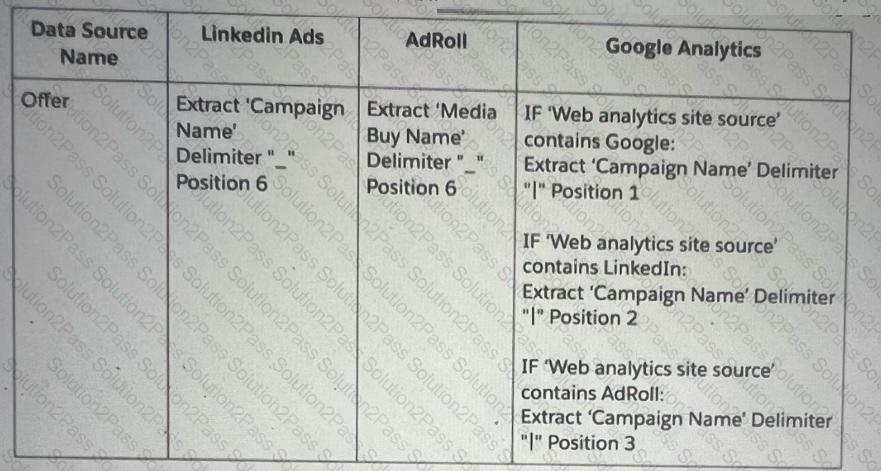
The implementation engineer to use the Harmonization Center. Which of the below actions can help implement the new dimension ‘Offer?
A client has integrated data from Facebook Ads, Twitter Ads, and Google Ads in Marketing Cloud Intelligence. For each data source, the data
follows a naming convention as shown below:
Facebook Ads Naming Convention - Campaign Name:
Camp|D_CampName#Market_Objective#TargetAge_TargetGender
Twitter Ads Naming Convention - Media Buy Name:
Market|TargetAge|Objective|OrderID
' Google Ads Naming Convention - Media Buy Name:
Buying Type_Market_Objective
The client wants to harmonize their data on the common fields between these two platforms (i.e. Market and Objective) using the Harmonization ‘Center.
In addition to the previous details, the client provides the following data sample:
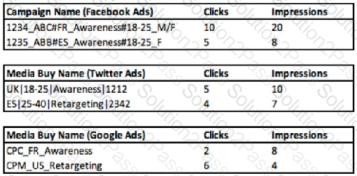
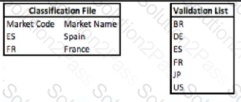
Logic specification:
If a value is not present in the Validation List, return “Not Valid”
If a value is not present in the Classification File, return “Unclassified”.
If the Harmonization center is used to harmonize the above data and files, what table will show the final output?
A)

B)

C)

D)

An implementation engineer is requested to extract the first three-letter segment of the Campaign Name values.
For example:
Campaign Name: AFD@Mulop-1290
Desired outcome: AFD
Other examples:

Which formula will return the desired values?
An implementation engineer has been asked to perform a QA for a newly created harmonization field, Color, implemented by a client.
The source file that was ingested can be seen below:

The client performed the below standard mapping:
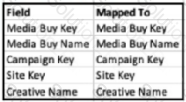
As a final step, the client had created the field ‘Color’. As can be seen, it is extracted from the Creative Name (after the ‘#’ sign).
For QA purposes, you have queried a pivot table, with the following fields:
* Media Buy Key
* Media Buy Name
* In View Impressions
The final pivot is presented below:

A client wants to integrate their data within Marketing Cloud Intelligence to optimize their marketing Insights and cross-channel marketing activity analysis. Below are details regarding the different data sources and the number of data streams required for each source.
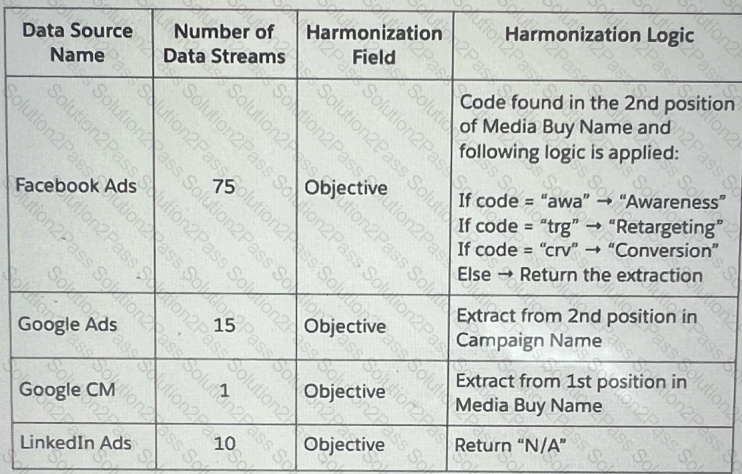
Which three advantages does a client gain from using Calculated Dimensions as the harmonization method for creating the Objective field?
Ina workspace that contains one hundred data streams and a lot of data, what is the biggest downside of using calculated dimensions?
A client would like to integrate the following two sources:
Google Campaign Manager:

IAS:

After configuring a Parent-Child relationship between the files, which query should an implementation engineer run in order to QA the setup?
A client provides the following two data streams:
Data Stream 1:
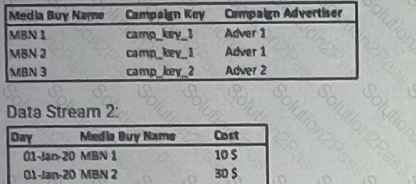
Question-
The client would like to use a VLOOKUP formula to calculate the Cost per Campaign Advertiser on January 1st 2020. Which mapping options should the client apply to obtain the expected result?
A)

B)

C)

D)

A technical architect is provided with the logic and Opportunity file shown below:
The opportunity status logic is as follows:
For the opportunity stages “Interest”, “Confirmed Interest” and “Registered”, the status should be “Open”.
For the opportunity stage “Closed”, the opportunity status should be closed.
Otherwise, return null for the opportunity status.
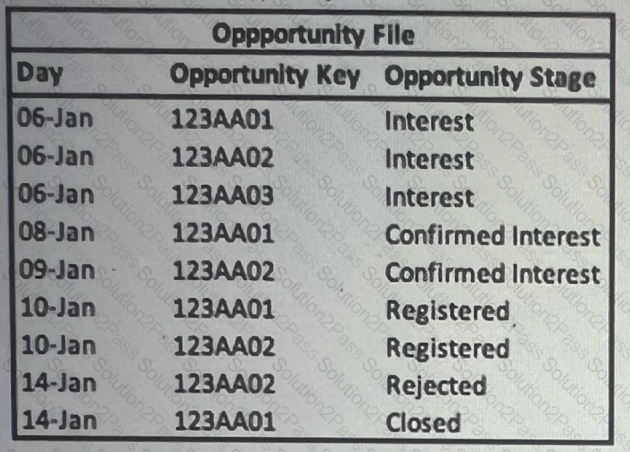
Given the above file and logic and assuming that the file is mapped in a GENERIC data stream type with the following mapping:
“Day” — Standard “Day” field
“Opportunity Key” > Main Generic Entity Key
“Opportunity Stage” — Generic Entity key 2
A pivot table was created to present the count of opportunities in each stage. The pivot table is filtered on Jan 7th -11th.Which option reflects the stage(s) the opportunity key 123AA01 is associated with?
Which two statements are correct regarding LiteConnect?
Your client provided the following sources:
Source 1:
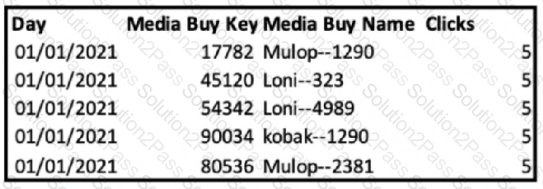
Source 2:
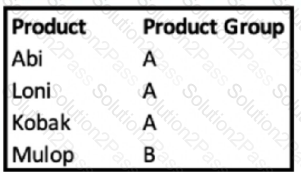
Source 3:
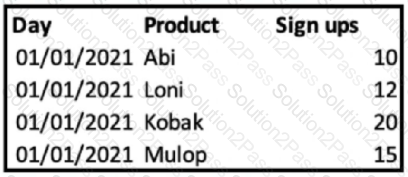
As can be seen, the Product values present in sources 2 and 3 are similar and can be linked with the first extraction from ‘Media Buy Name’ in source1
The end goal is to achieve a final view of Product Group alongside Clicks and Sign Ups, as described below:

Which two options will meet the client’s requirement and enable the desired view?
The following file was uploaded into Marketing Cloud Intelligence as a Generic Data Stream type:

The mapping is as follows:
Day — Day
web_site_key —> Main Generic Entity Key
web_site_name —> Main Generic Entity Name
Web_site_source —> Main Generic Entity Attribute 01
Page Views — Generic Metric 1
How many rows will be stored in Marketing Cloud Intelligence after the above file is ingested?
